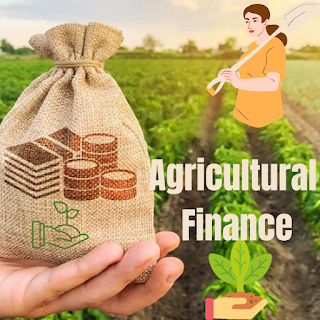Farmers and Agricultural Finance
Agriculture Sector:
Due to a significant increase in global population and shifting dietary preferences of the burgeoning middle class in developing economies towards better value agricultural goods, there is an ever-increasing need to invest in agriculture. Climate hazards also enhance the need for investments in agriculture to make it more robust to such risks.
According to estimates, food consumption would rise by 70% by 2050, necessitating yearly investments of at least $80 billion, the majority of which will have to come from the private sector. In comparison to the agriculture sector's percentage of GDP, financial sector institutions in developing nations lend a disproportionately smaller fraction of their loan portfolios to agriculture.
Credit for Agricultural Production
Credit is an important factor for agricultural production. Credit has played an important role in the policy making of the agricultural sector in India since independence. The banking system works closely with the State Governments to ensure timely and adequate credit to the farmer.
The growing interest of the middle class in the modern market and the growing global population in favor of higher agricultural value-added products are increasing the need for more investment in the agricultural sector.
Limitations
On the other hand, a number of issues limit the expansion and development of farm financing markets, including:
- inadequate or ineffective policies
- high transaction costs to reach remote rural population
- production, market, and price risk covariance
- a lack of effective risk management tools
- Low demand owing to fragmentation and the early stages of value chain development
- financial institutions' lack of experience handling agricultural loan portfolios
Concerns:
Remedial Measures
More studies and research articles are given as links below
Related Topic: Advantages of selling goods in a cooperative market run by themselves – farmers' perspective.
B. Com. / M. Com. Project Topics
B. A. / M. A. Economics Project Topics
കാര്ഷിക ഉല്പാദനത്തിന് വായ്പ ഒരു പ്രധാന ഘടകമാണ്. സ്വാതന്ത്ര്യലബ്ധിക്കുമുതല്തന്നെ ഇന്ത്യയിലെ കാര്ഷികമേഖലയിലെ നയരൂപീകരണത്തില് വായ്പയ്ക്കു് ഒരു പ്രധാന സ്ഥാനം ലഭ്യമായിട്ടുണ്ടു്. കര്ഷകന് സമയബന്ധിതവും മതിയായതുമായ വായ്പ ലഭ്യത ഉറപ്പു വരുത്തുന്നതിനായി ബാങ്കിംഗ് സംവിധാനം സംസ്ഥാന സര്ക്കാരുമായി ചേര്ന്ന് പ്രവര്ത്തിക്കുന്നു. ഉയര്ന്ന കാര്ഷിക മൂല്യവര്ദ്ധിത ഉല്പനങ്ങള്ക്കനുകൂലമായ രീതിയില് നൂതന വിപണിയിലെ മധ്യവര്ഗ്ഗത്തിന്റെ വര്ദ്ധിച്ച ആഭിമുഖ്യവും വളര്ന്നുവരുന്ന ആഗോള ജനസംഖ്യയും കാര്ഷിക മേഖലയില് കൂടുതല് നിക്ഷേപം നടത്തുന്നതിന്റെ ആവശ്യകത വര്ദ്ധിപ്പിക്കുന്നു.
കാര്ഷിക മേഖലയുടെ ദീര്ഘകാല വികസനത്തിന് കൃഷിയ്ക്കായുള്ള ദീര്ഘകാല വായ്പ അത്യാവശ്യമായ ഒന്നാണ്. കാരണം ഇത് മൂലധന രൂപീകരണ പ്രക്രിയയെ സഹായിക്കുന്നു. കേരളത്തിലും കഴിഞ്ഞ അഞ്ചു വര്ഷത്തിനിടയില് കാര്ഷികമേഖലയ്ക്കു നല്കുന്ന വായ്പകള് ഗണ്യമായി വര്ദ്ധിച്ചിട്ടുണ്ടു്. 2016-17 ല് 54,270.00 കോടി രൂപയും 2017-18 ല് 67,089.00 കോടി രൂപയും 2018-19 ല് 71,632.00 കോടി രൂപയും 2019-20 ല് 73,034.00 കോടി രൂപയുമായി കാര്ഷികവായ്പയില് ഗണ്യമായ വര്ദ്ധനവ് ഉണ്ടായിട്ടുണ്ട്. 2018-19 ല് വിതരണം ചെയ്ത മൊത്തം കാര്ഷിക വായ്പ 71,632.00 കോടി രൂപയാണ്. ആകെ കാര്ഷിക വായ്പയില് 32,613.59 കോടി രൂപ വാണിജ്യ ബാങ്കുകള് വഴിയും 10,233.36 കോടി രൂപ പ്രാദേശിക ഗ്രാമീണ ബാങ്കുകള് വഴിയും 13,476.96 കോടി രൂപ കോ-ഓപ്പറേറ്റീവ് ബാങ്കുകള് വഴിയും 2018-19 ല് കാര്ഷിക വായ്പയായി വിതരണം ചെയ്തിട്ടുണ്ടു്. കാര്ഷിക അനുബന്ധ വായ്പ ലഭ്യമാക്കുന്നതില് വാണിജ്യ ബാങ്കുകളുടെ പ്രാധാന്യം തുടര്ന്നുകൊണ്ടിരിക്കുന്നു എന്നതാണ് ഇത് സൂചിപ്പിക്കുന്നത്.
Kerala Economic Review - 2020 : Agriculture and Allied Sectors
Kerala Economic Review 2020 - Malayalam Version
WorldBank : Innovative Agricultural SME Finance Models
Challenges and impact of Agri finance on the socio economic status of Indian Farmer
Factors Affecting Small Farmers’ Access to Institutional Credit in Rural Orissa, India

Comments
Post a Comment